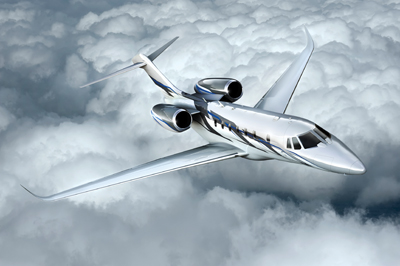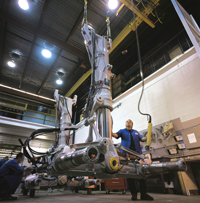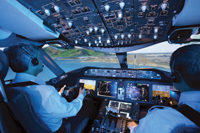
Features
Operations
A Smart Solution
Astate-of-the-art onboard cabin management system (CMS) is the brain of any intelligent aircraft – and today’s CMS offerings are certainly showing off high IQs.
January 10, 2011 By James Careless
Astate-of-the-art onboard cabin management system (CMS) is the brain of any intelligent aircraft – and today’s CMS offerings are certainly showing off high IQs.
 |
|
| The Cessna Citation Ten business jet will boast a state-of-the art cabin management system. PHOTO: Cessna
|
To wit, here’s a sampling of the cutting-edge advancements transforming modern business aircraft: iPads serving as onboard control systems; HDTVs; touchscreens; Android handsets; satellite broadband and fibre-optic backbones. It’s a trend that indicates just how attuned manufacturers such as Cessna, EMS Aviation, Flight Display Systems, InspecTech Aero Service and Rockwell Collins are to the tastes of their business aircraft customers. It’s also an indication of how far CMS has progressed from the early days of stereo audio, a TV monitor and a VCR.
“The rapid evolution of mobile technology development is driving new and exciting introductions into the consumer product arena, which is greatly influencing how customers view cabin management systems today,” says Cindy Halsey, Cessna’s VP of interior design engineering and development. “What began as simple lighting and audio control systems has evolved into complex ambience, entertainment and cabin communication management systems. Technological developments such as flat screen monitors, DVDs, MP3 players, LED lighting, Internet, Wi-Fi, Blu-ray, OLED displays, GUIs (graphical user interfaces), iPhone, Android – and the list goes on at an unprecedented pace – are posing amazing opportunities and incredible challenges to the aviation sector.”
Pam Tvrdy, manager of media relations with Rockwell Collins, agrees. She says the major driver is the desire for passengers to have access to an office and entertainment environment that mirrors what they have when they are on the ground. “Because the consumer marketplace changes so rapidly, it’s critical to have a cabin management system that can easily adapt to new technology,” she says.
The sky’s the limit
The new CMS products introduced in the past few months speak volumes about what customers want, and where the CMS market is going.
A case in point: Cessna’s new CMS, which was developed for the just announced Citation Ten business jet, integrates the aircraft’s avionics, electrical systems, communications and CMS via a fibre optic-connected, touchscreen controlled command system. This is a quantum leap beyond CMS as a distraction for bored passengers.
“The Cessna CMS features an interactive, touch-screen system controller at each passenger seat for audio (digital media, MP3/iPhone), video (digital, Blu-ray), interactive moving map, cabin temperature, lights, window shades and even cabin diagnostics,” says Halsey. “The dual club-seat cabin arrangement also includes 110- or 220-volt electrical outlets and multiple USB/device inputs. High-speed Internet browsing, satellite radio and cabin Wi-Fi are available as options.”
Meanwhile, the Cessna CMS trip computer includes an interactive moving map with a global database featuring standard features such as flight data displays and location indicator, and also offers access to points of interest information.
EMS Aviation’s latest CMS offering is its new Aspire family of in-flight communications products. Due to be released in 2011, the system’s corded and wireless touchscreen handsets are based on Google’s Android mobile phone platform. This means it provides users with the kind of interactive experience found in the latest mobile smartphones. Since aircraft don’t use terrestrial cellular services as a rule, voice and data service is carried using Iridium and INMARSAT satellites. “The handsets also offer e-mail and with third-party apps, the ability to manage cabin functions such as dimming the lights or turning on an entertainment system,” says Kate Murchison, marketing director with EMS Aviation-Ottawa. “They are designed to work with the Aspire system, but any Android application could be installed on the device.”
EMS plans to introduce the product line in phases. The Aspire family of communication systems will offer various services from voice and/or data to high-speed Internet, while also providing flexible installation and customizable capabilities and bandwidth. Owners and operators can easily change or upgrade systems without rewiring. For airframe manufacturers, such flexibility allows them to wire an aircraft early in the production process without having to commit to a specific system until much later. EMS is just one example of how OEMS are trying to reduce the total cost and rework efforts when changes or updates are underway and thus encourage both new and retrofit work.
 |
|
| The Venue system from Rockwell Collins addresses the need to incorporate high-definition and digital media needs into the cabin management system. It can scale into anything from a Cessna CJ4 to a larger Boeing business jet. | |
 |
|
| Building on the iPad craze, Flight Display Systems has come up with an iPad display mount, which works for vertical or horizontal configurations, making it easy to control the cabin systems from your seat.PHOTOs (top): Rockwell Collins, (bottom): Flight Display Systems
|
Something for everyone
Own an older aircraft? Then consider Flight Display Systems for a CMS. Nick Gray, Flight Display Systems’ director of international sales, says its CMS is the first one designed specifically for the retrofit market. “We feature a full 1080p backbone for high-definition content so VIP operators get VIP video quality,” he says. Aircraft capable of using “Club CMS” upgrades include the Cessna Citation and Embraer Phenom. Flight Display System has also come out with an iPad-mounting arm, which can hold an iPad at a passenger seat in either a vertical or horizontal configuration.
“I have a 1981 airplane, but when you go inside the door it feels like 2010,” says Bill Upton, owner/pilot of a Citation II. “Flight Display Systems is a big part of that. We have their Moving Map, DVD player, and a bunch of LCD monitors at each seat. I have six kids and we all love it.”
So, why has Flight Display Systems targeted the retrofit market? “With the recession, many new aircraft sales have been cancelled,” Gray says. “Aircraft operators are refurbishing existing aircraft instead of buying brand new planes.”
InspecTech Aero Service is showing just how far consumer technology can be integrated in a CMS, by adopting the Apple OS (operating system) to drive its “iCabin” Cabin Management System and In-Flight Entertainment and Connectivity System (IFE) for business jets. Rather than install iPod docking stations, InspecTech has made the iPod, iPad and iPhone integral part of its approach to CMS. In fact, iCabin is controlled using an iPad touch menu, with iPads mounted at every passenger seat to make this easy and accessible.
“Using Apple and iPad technology acknowledges the need to integrate advanced consumer electronic products and software into aircraft,” says Jim Lang, president of InspecTech. “It just makes sense to use popular yet capable consumer technology to control and operate all of the various CMS functions. The approach is efficient, the technology is proven, and customers like it.”
Rockwell Collins is also pushing the VIP CMS envelope with “Venue.” Designed to integrate full work-related functions with high-end entertainment, “Venue incorporates high definition home-theatre capabilities, support for personal and portable electronic devices, enhanced mobile office services, connectivity, and full-cabin environmental controls,” says Tvrdy. “Venue was created to address the emergence of high-definition and digital media to fill the need for a cabin management system that could scale the wide range of business aviation aircraft sizes and application – from a Cessna CJ4 to a Boeing Business Jet.”
Taken as a whole, the trend towards cutting-edge CMS is undeniable. The addition of iPads as peripheral or – in the case of InspecTech Aero Service – central elements of an aircraft CMS indicates just how influential consumer technology has become in this market.
Are people buying?
All this sexy technology begs a big question: Are aircraft owners/operators actually buying cutting-edge CMS?
The answer to this question is akin to a doubled-edged sword. On the one hand, the global recession is definitely hurting CMS sales. “It is a very tight market right now,” says Halsey. “Two years ago the industry was going at an unprecedented pace in deliveries. As the numbers of deliveries went down, the players are all competing for a smaller pool.”
On the other hand, there is a revolution occurring in consumer technology, and aircraft owners, operators and passengers want this technology available everywhere – including in the air. “Carry-on equipment such as laptops, iPhones, and other MP3 players mean that IFE systems need to accommodate passenger media,” says Gray. “Besides, a new CMS can help modernize the aircraft interior. Nobody wants to pay thousands of dollars to fly in an aircraft with a VHS deck and cassette tape radio.”
Taken as a whole, these two factors mean CMS sales today are very much driven by whatever consumer tech has taken root with the flying public. This trend is not limited to the CMS market sector: “New technology has proven to be a leading driver of growth in all industries,” says Halsey. “Historically, CMS was not considered a necessity, but a luxury and more popular in long range general aviation and transport products. But the influences of automotive and consumer mobile devices have fuelled the appetite for connectivity, and OEMs are seeing this as an opportunity to differentiate their products from the pack. The key to success is to find the attributes that people are willing to pay for.”
The bottom line: Those considering CMS systems – whether for their own use, or to attract and keep customers – would be well-advised to keep on top of consumer trends, and see how those trends are being translated into aircraft cabins. The days when trailing-edge CMS could be rationalized away as “aviation specific applications” are over. Consumers want their iPads and iPhones – and they want them everywhere.